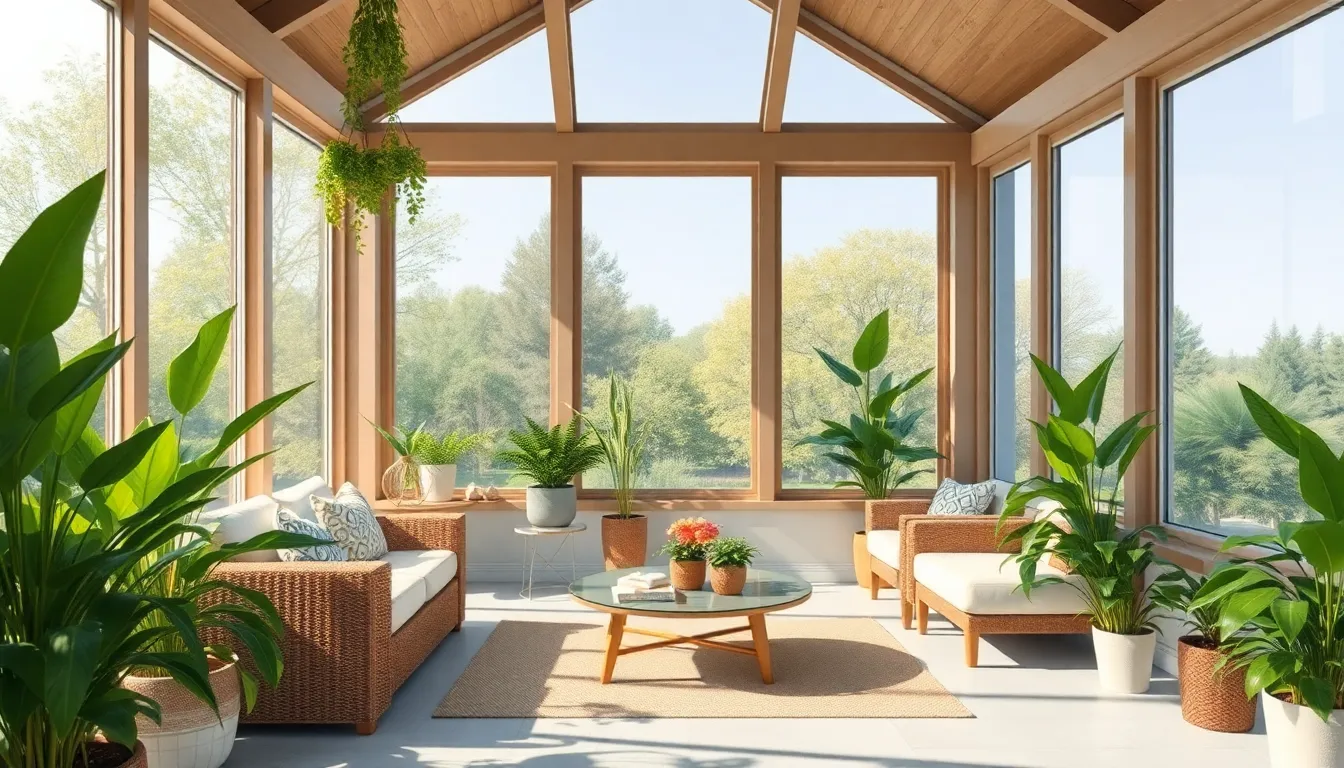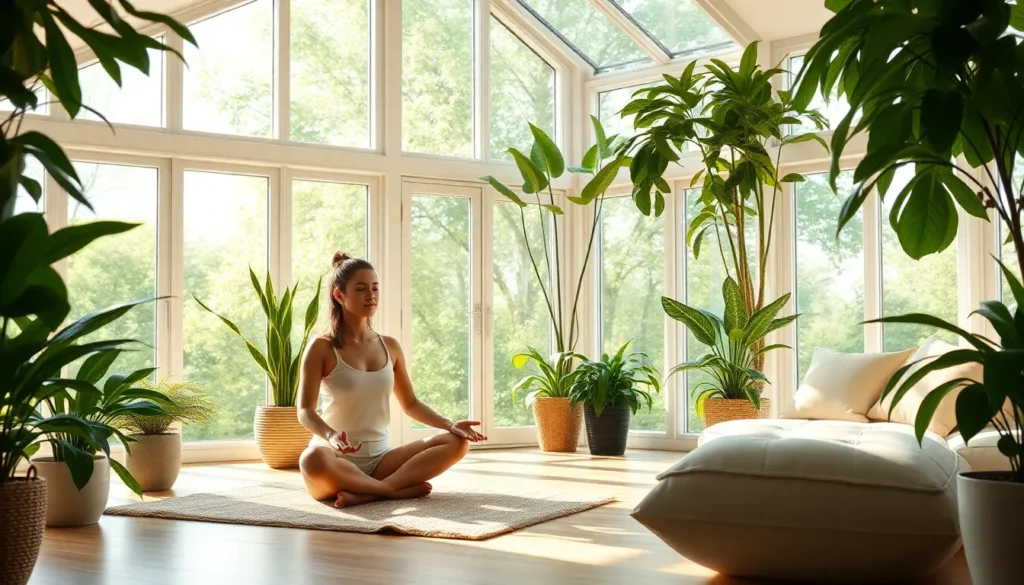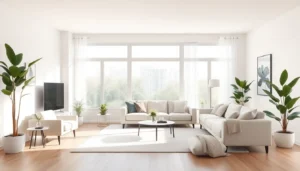Imagine sipping your morning coffee while basking in the warmth of the sun, surrounded by lush greenery, all from the comfort of your own home. A sunroom addition isn’t just an upgrade; it’s a lifestyle change that transforms ordinary living into a sun-soaked paradise. Who wouldn’t want a space that invites nature in while keeping the outside world at bay?
Adding a sunroom can boost your home’s value and provide a cozy nook for relaxation, family gatherings, or even that yoga session you keep promising yourself. It’s like giving your home a hug from the sun, and let’s be honest, who doesn’t need a little more sunshine in their life? Whether it’s a reading retreat or a plant lover’s haven, a sunroom is the perfect way to expand your living space while soaking up all the benefits of natural light.
Table of Contents
ToggleOverview of Sunroom Additions
Sunroom additions create bright spaces that blend indoor comfort with outdoor beauty. Homeowners frequently opt for sunrooms to transform underutilized areas into inviting environments. This enhancement introduces more natural light into living areas, promoting a cheerful atmosphere. Many choose sunrooms for relaxation, family gathering, or hobbies like reading and painting.
A variety of styles exists for sunroom designs. They can include three-season and four-season sunrooms, depending on climate and usage preferences. Three-season sunrooms typically feature screens or windows that allow for seasonal enjoyment. In contrast, four-season sunrooms provide year-round comfort with climate control.
Materials used in sunroom construction also vary. Common options include wood, aluminum, and vinyl, each offering unique durability and aesthetics. Glass choices play a significant role; tempered glass and low-E glass improve energy efficiency while minimizing glare.
Investing in a sunroom addition often increases home value significantly. According to Remodeling Magazine, homeowners can expect a return on investment of about 50% to 70%. This value boost enhances marketability, making the property appealing to potential buyers.
Permits and zoning regulations may apply when building a sunroom. Local authorities require compliance with building codes to ensure safety and structural integrity. Consulting with professionals can streamline this process and ensure adherence to all necessary regulations.
Ultimately, adding a sunroom serves to enhance the overall living experience. It embraces outdoor scenery while providing comfort inside. Features such as energy-efficient windows and insulation contribute to a sustainable home environment.
Benefits of a Sunroom Addition

Adding a sunroom offers several advantages, enhancing both lifestyle and home value. Below are the main benefits that stand out.
Increased Natural Light
Natural light floods a sunroom, brightening up the entire home. Enhanced exposure to sunlight promotes a healthier living environment by improving mood and energy levels. Studies indicate that exposure to natural light can lead to increased productivity and well-being. Sunrooms serve as remarkable spaces for indoor plants, benefiting from this abundant light. When designed with energy-efficient glass, they minimize heat loss while maximizing luminosity. Homeowners often find that sunrooms create a warm and welcoming atmosphere, fostering relaxation and joy.
Enhanced Living Space
A sunroom effectively expands the usable area of a home, transforming underutilized space into a multifunctional room. This addition accommodates diverse activities, from casual family gatherings to yoga sessions or reading nooks. Families can enjoy quality time in a cozy environment that bridges indoor and outdoor living. Furthermore, sunrooms increase the aesthetic appeal of the property, which can attract potential buyers. With options available for both three-season and four-season designs, homeowners can customize their sunroom to fit their climate preferences and lifestyle needs. Overall, the enhanced living space can significantly improve the functionality and ambiance of a home.
Types of Sunroom Additions
Sunroom additions come in various styles catering to different preferences and needs. The two main types are four-season and three-season sunrooms.
Four-Season Sunrooms
Four-season sunrooms provide year-round enjoyment, making them ideal for all climates. These structures feature insulated walls and roofs designed for temperature regulation. Energy-efficient glass enhances comfort by minimizing heat loss during colder months. Natural light fills the space, creating a warm and inviting atmosphere. Various design options exist, allowing homeowners to match the sunroom to their existing architecture. This versatility ensures an aesthetically pleasing addition that boosts overall property value. Families can enjoy cozy gatherings, relaxing afternoons, or peaceful retreats in these versatile rooms.
Three-Season Sunrooms
Three-season sunrooms offer a more budget-friendly option for moderate climates. These sunrooms typically lack heating and are best for spring, summer, and fall usage. Constructed with large windows, they maximize views while allowing fresh air circulation. They often feature screens to keep insects out, making them perfect for outdoor-like enjoyment. Homeowners appreciate their role in expanding living space, serving as areas for relaxation or socializing without the full commitment of a four-season addition. Flexible design options help integrate these spaces seamlessly into existing homes.
Considerations Before Adding a Sunroom
Certain factors influence the decision to add a sunroom. Understanding these considerations can lead to a successful addition.
Budget and Costs
Costs for a sunroom addition vary based on design, materials, and size. Expect an expenditure ranging from $15,000 to over $70,000, with a standard four-season sunroom typically costing more than a three-season alternative. It’s essential to factor in additional expenses, such as permits, site preparation, and interior finishing. A detailed budget helps prioritize features and align with financial capabilities. Homeowners often report a return on investment of around 50% to 70% upon resale, making the combination of initial costs and long-term value crucial in decision-making.
Local Building Codes
Navigating local building codes proves vital when adding a sunroom. Each jurisdiction has specific requirements regarding permits, zoning, and construction standards. Addressing these regulations ensures adherence to safety protocols and minimizes potential issues. Consulting with local authorities or a professional contractor streamlines the process. Some areas might restrict sunroom sizes, styles, or placements due to property lines or neighborhood aesthetics. Awareness of these parameters saves time and resources, facilitating a smoother construction experience.
A sunroom addition can truly transform a home into a brighter and more inviting space. By seamlessly blending indoor comfort with outdoor beauty, it creates an environment that enhances daily living. The potential for increased home value is a significant advantage, making it a smart investment for homeowners.
Whether opting for a four-season or three-season sunroom, the choice ultimately depends on individual preferences and climate needs. With careful planning and consideration of local regulations, homeowners can enjoy the many benefits that a sunroom brings, from improved aesthetics to a healthier living environment. Embracing natural light and the beauty of the outdoors has never been more accessible.





